Winners of the 2023 HODI Award in Built Heritage Conservation
May 18, 2023
Carleton University and the Board of Directors of Historic Ottawa Development Inc. (HODI) have announced the winners of the 2023 HODI Award in Built Heritage Conservation. These are the seventh annual awards since the first HODI competition in 2016.
This year, there were six entries: one graduate and four undergraduate teams from the Azrieli School of Architecture & Urbanism (ASAU) Conservation and Sustainability program and one undergraduate team from the Department of Civil and Environmental Engineering (CEE) Architectural Conservation and Sustainability Engineering program.
Cloé Beaudry, Jemma Johnson, and Kayla Wallace were awarded first place for their project Intertwine for the rehabilitation and adaptive reuse of the E.B. Eddy complex in Gatineau, QC. They will receive $3,500. The architecture students produced the project in a design studio led by Adjunct Professor Lyette Fortin. Beaudry, Johnson, and Wallace have completed the third year of the ASAU undergraduate program in Conservation and Sustainability.
Melissa Brady was awarded second place for her thesis project From Communal Services to Social Resilience: Creating a New Life for the Smiths Falls Former Water Treatment Plant. She will receive $2,000. Brady is a 2023 graduate of the ASAU Master of Architecture program. Her thesis advisors were Associate Professor Mariana Esponda and Professor Mario Santana Quintero.
Kate Wishewan, Abi Kang, Ayah Hassan, Dakota Wehbe, Elizabeth Paikoff, and Jessalyn Beich were awarded third place for their final year Engineering Capstone Project, Rehabilitation of 25 Old Mill Road, which proposed a conservation and rehabilitation plan for the former water treatment plant in Smiths Falls, ON. They will receive $1,500. Professor Mario Santana Quintero led the project. The fourth-year students are 2023 graduates of the CEE undergraduate program in Architectural Conservation and Sustainability.
The jury was impressed with the overall quality of all the submissions in what has been a difficult year for students and commended each of the entrants for participating in HODI.
Dr. Esponda noted that on May 8 a fire caused heavy damage to the former water treatment plant in Smith’s Falls — the site of two winning projects.
“Fire is one of the major threats to the preservation of existing and heritage buildings,” she said. “One of the goals we teach our conservation students is to protect built heritage from fire hazards and to contribute to more sustainable construction. Accurate documentation, before the fire, is a key factor to protect built heritage, mitigate their risk and to adopt appropriate maintenance for future control strategies.”
The thesis work by Brady and the fourth-year project by engineering students Kang, Wishewan, Hassan, Wehbe, Paikoff, and Beich shows how significant it is to perform digital documentation work and how vulnerable heritage places are if they are left abandoned and unused, she added.
Brady expressed sadness at the damage to the structure. “This thesis work was conducted so that the memory of the former water treatment plant would be preserved for future generations to experience,” she said. “I hope that my work can be useful in any efforts to restore and repair the damage or to help inspire meaningful rebuilds.”
First Place
Recipients: Cloé Beaudry, Jemma Johnson, and Kayla Wallace
Project: Intertwine
Our project proposes the rehabilitation and adaptive reuse of the E.B. Eddy complex in Gatineau, QC, into the Outaouais Regional Museum to promote ideas of diversity, education, and community. It focuses on the idea of intertwining — to unite, to be mutually involved, and to be closely connected. This concept is rooted in the museum, which focuses on bringing together the region’s history and culture into a place where it can be celebrated, and community members can identify with it and connect. The idea also stems from the condition of the E.B. Eddy buildings, which call for the intertwining of old and new fabric.
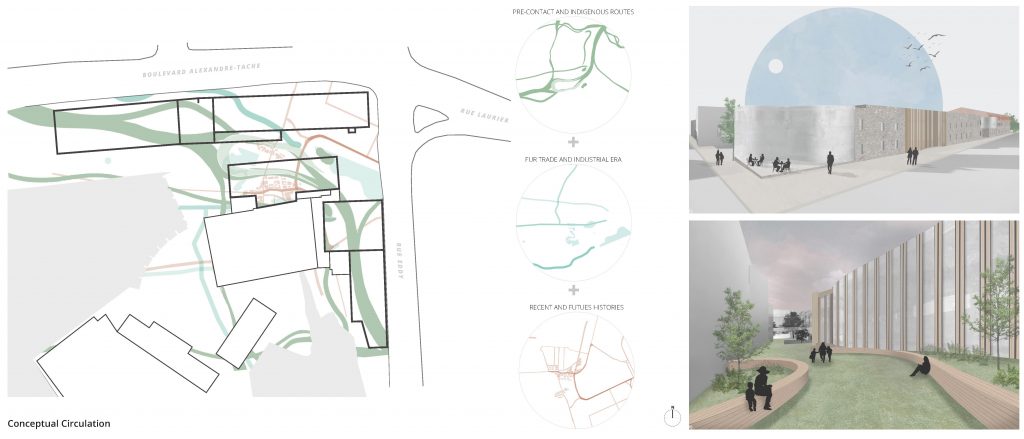
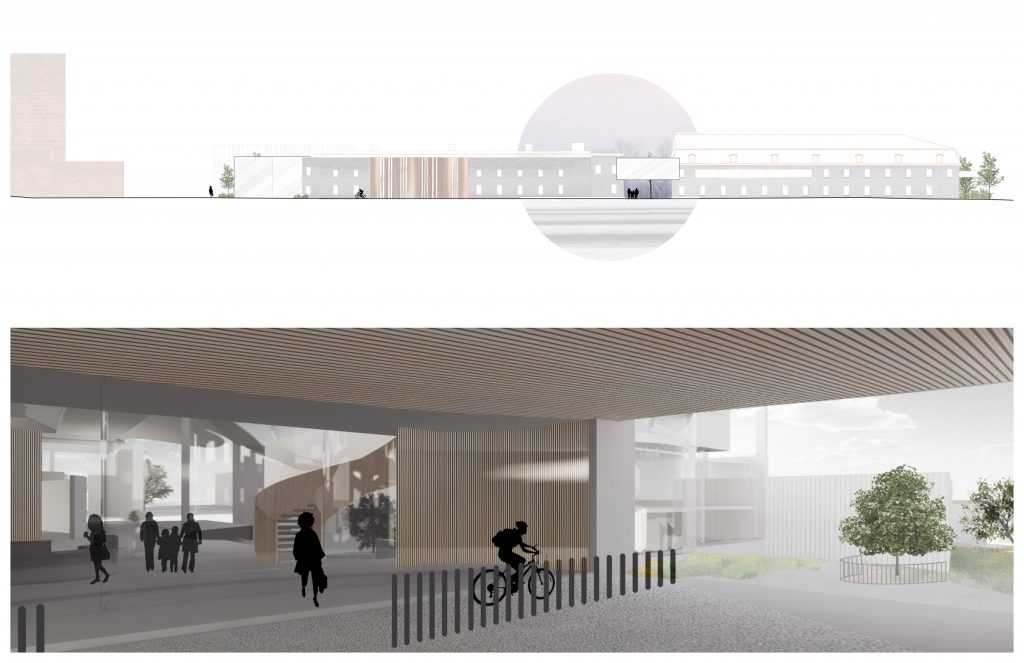
Jury Comments
This project provides a good example of adaptive reuse. The jury appreciated the team’s precision in referencing preservation standards and their efforts to address the challenges of the site. The new build is distinguishable from and respectful of the original structures. Its light volumes make a convincing use of contrast against the massive industrial buildings. Retention of the complex original massing, combined with restoration of the original architectural elements, blends successfully with new interiors. The curved forms of the new additions increase the fluidity of the new build and soften its impact. Finally, the massing, materials, and form of the addition maintain the character of the streetscape.
Second Place
Recipient: Melissa Brady
Project: From Communal Services to Social Resilience: Creating a New Life for the Smiths Falls Former Water Treatment Plant
Once a vital aspect of Smiths Falls’ service infrastructure, the Waterworks Buildings at 25 Old Mill Road are located adjacent to the downtown area. These provincially designated heritage buildings have been abandoned since 2010 due to the construction of a new water treatment facility nearby and have since experienced substantial deterioration. The buildings are historically significant, representing Smiths Falls’ industrial past and evolution. This thesis project explores using existing conservation practices, such as The Standards & Guidelines for the Conservation of Historic Places in Canada and the Nara Grid, to address the conditions of the site and its heritage values. Design was also used to explore a sensitive approach for the adaptive reuse of the buildings, with the goal of creating a new, sustainable multi-use community hub for the Town of Smiths Falls.
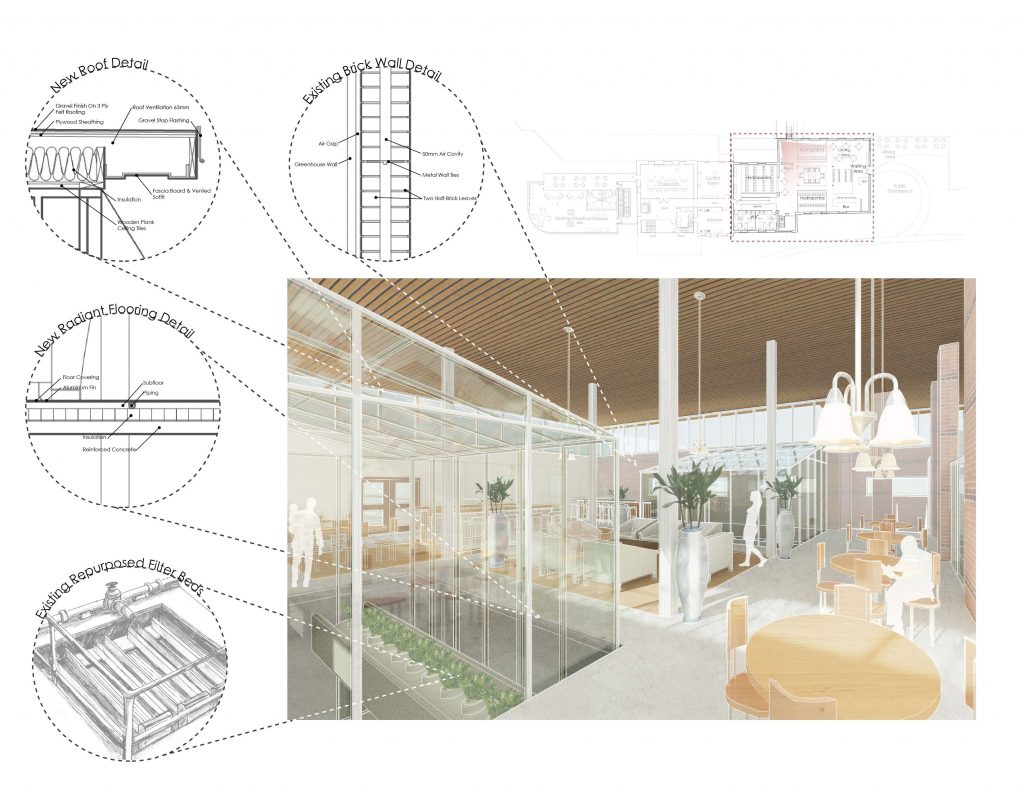
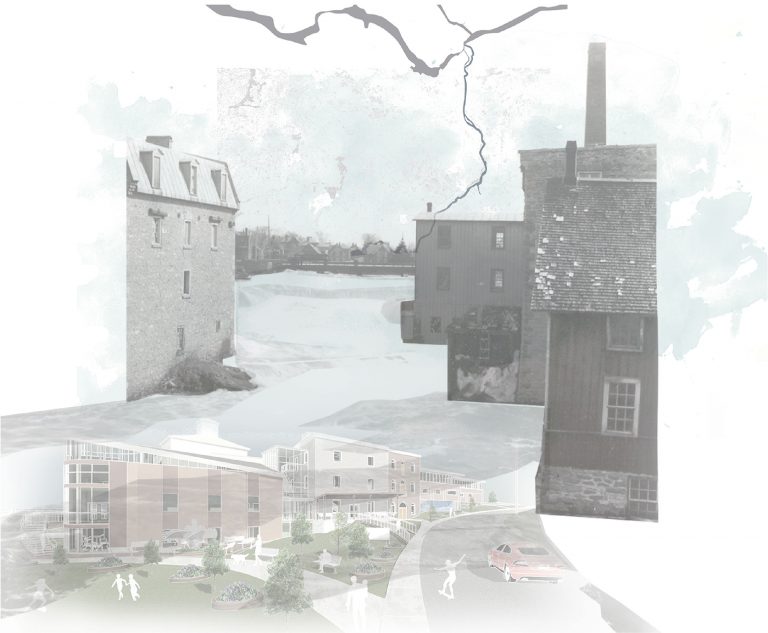
Jury Comments
This is a highly successful repurposing of the industrial, architectural heritage, with excellent site recording and analysis. The project demonstrates how the adaptive reuse of an abandoned industrial site can transform the dynamics of a neighborhood and support its continuity while recognizing the strong connection to historic community events. The jury appreciated the textual and graphic analysis of the context and evolution of the site, especially the mapping of comparative historical mills along the Rideau Canal, as well as the mapping of proposed interventions and programming. The community survey provided a welcome additional level of input. The design project exhibits sensitivity to the impact of interventions by limiting the new build to the footprint of the demolished building. The coherence of completed additions is achieved by their compatibility with heritage structures. The detailed restoration work is in balance with structural upgrades and repurposing of the original features. The multi-use community centre program demonstrates much-needed flexibility in adapting to changing community needs.
Third Place
Recipients: Kate Wishewan, Abi Kang, Ayah Hassan, Dakota Wehbe, Elizabeth Paikoff, and Jessalyn Beich
Project: Rehabilitation of 25 Old Mill Road
The objective of the project was to rehabilitate the former water treatment plant and introduce new functions into the building complex to reintegrate it back into the community. To successfully implement the adaptive reuse, the project team conducted a detailed site condition and historical evaluation, heritage-value and character-defining elements designation, a thorough study of function choice and architectural design implementation, and proposed building envelope and structural designs. In addition, a detailed conservation and maintenance plan to restore the site to a safe, presentable, and durable condition was developed. A major priority of the project was ensuring the historic site could be successfully integrated into the community while protecting all significant heritage elements.
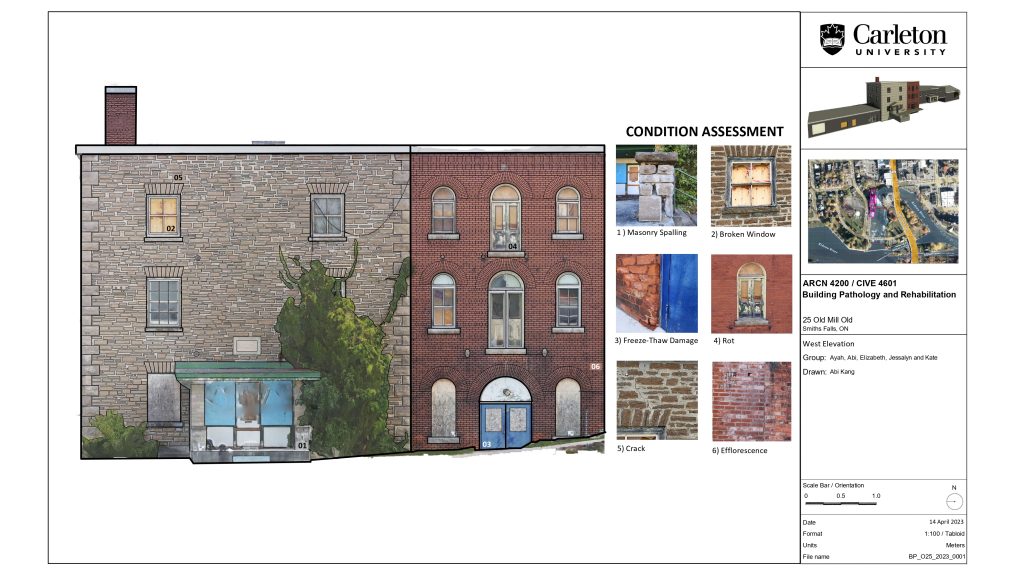

Jury Comments
This team delivered an impressive analysis and treatment plan. The conservation approach was clear and comprehensive, proceeding carefully through three phases of understanding, planning, and intervening. Their reasoning and analysis through each task in the plan’s development was carefully documented, well-supported, and clearly expressed. The adaptive reuse design exhibits a strong contemporary quality while supporting the historic setting.
Established in 2015, the HODI Award for Built Heritage Conservation is awarded annually to outstanding students at Carleton University in the Azrieli School of Architecture & Urbanism, the Department of Civil and Environmental Engineering and the School of Indigenous and Canadian Studies. Recipients are involved in projects aimed at safeguarding and rehabilitating historic buildings and sites in Ottawa.
The award provides the opportunity for HODI to support the emerging generation of conservation professionals in researching, learning, and practising in Ottawa. It helps build the capacity needed to deliver conservation best practices for Ottawa’s built heritage, now and into the future.
The formal awards will take place in June 2023 in connection with graduation events for the Azrieli School of Architecture & Urbanism. The HODI competition for 2023-24 will launch at the Carleton University Welcome Day event in September 2023.
The awards jury for 2023 comprised:
• Andrew Waldron, Executive Director, Canadian Association of Heritage Professionals (CAHP);
• Lisa Nicol, Partner, John G. Cooke & Associates Ltd. Engineers;
• Barbara Myslinski, Secretary, HODI;
• Laurie Smith, Manager of Research Operations, Carleton Immersive Media Studio, Carleton University;
• Mariana Esponda, Associate Professor and Coordinator, Conservation and Sustainability Program, Azrieli School of Architecture & Urbanism, Carleton University.
Historic Ottawa Development Inc. (HODI) offers professional advice, advocacy support and partnership opportunities to inspire and celebrate the conservation of Ottawa’s built heritage. Its board of directors has expertise in architecture, restoration and historical research and can provide loans and grants to assist with the rehabilitation of historic properties and with public education projects. For information contact Sandy Smallwood at sandy@andrex.ca.